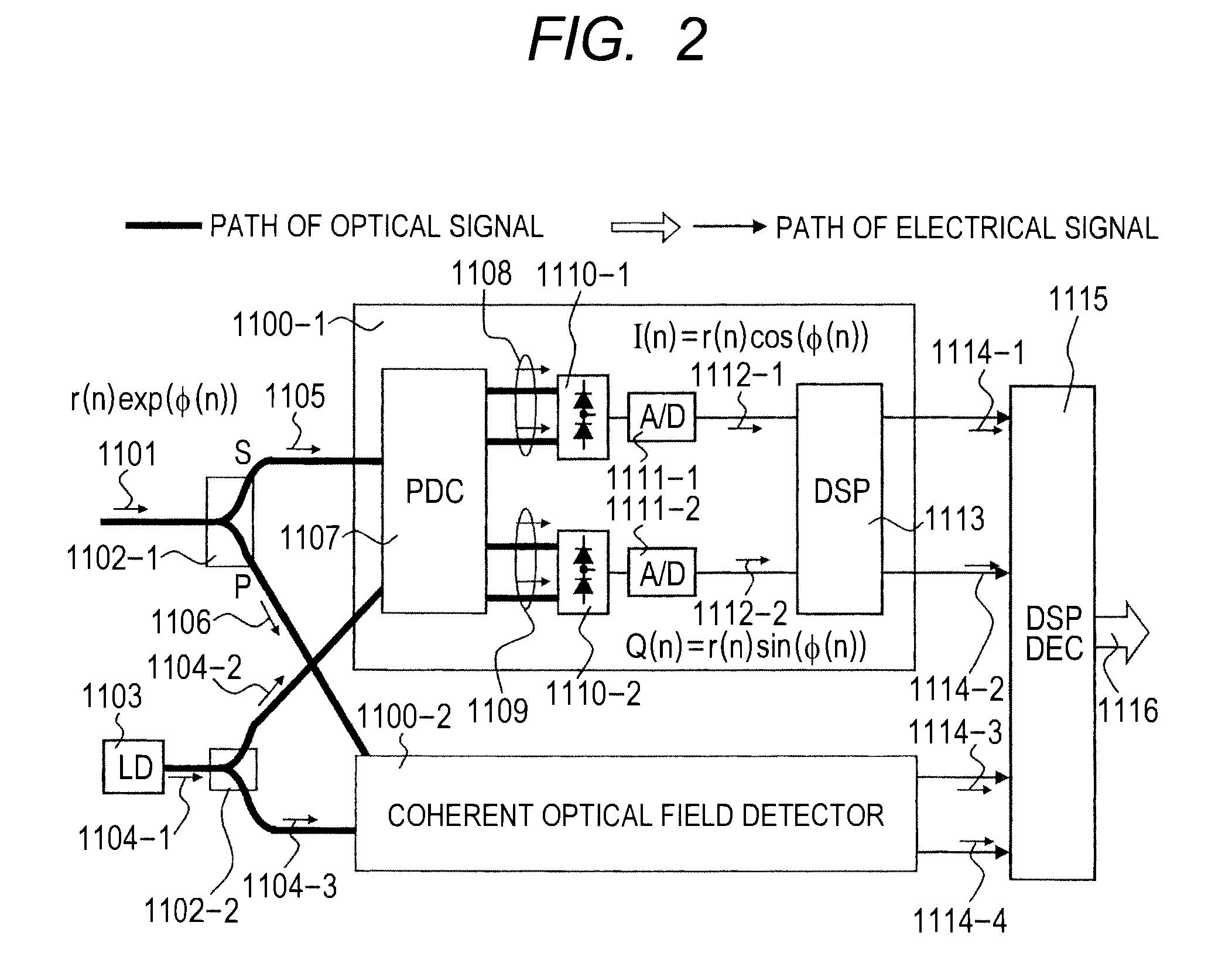Optical receiver and optical transmission system
a technology of optical transmission system and optical receiver, which is applied in the direction of electromagnetic transmission, electrical apparatus, transmission, etc., can solve the problems of insufficient wavelength dispersion compensation of electrical stages using the wavelength dispersion compensation technology of the related art, the size of the device, the complexity of the device, and the difficulty in achieving the resolution of the control speed,
- Summary
- Abstract
- Description
- Claims
- Application Information
AI Technical Summary
Benefits of technology
Problems solved by technology
Method used
Image
Examples
first embodiment
[0089]FIG. 5 is a block diagram of the first embodiment of the present invention and shows the structure of the optical electric field receiver(optical receiver) 300.
[0090]A receiving optical multilevel signal 215 is branched into three optical signal paths by an optical splitter 222 that are input to a first optical delay detector 223-1, a second optical delay detector 223-2, and an optical intensity receiver 225. This receiving optical multilevel signal 215 is an optical modulation signal with 2-level or more for a pre-established symbol time and that is sent from an optical transmitter and received by way of an optical fiber transmission path. The first optical delay detector 223-1 is set so that the delay time differential T of the two internal optical paths is approximately equivalent to a symbol time Ts of the optical multilevel information signal for receiving, and so that the optical phase differential on both paths reaches zero. The second optical delay detector 223-2 is se...
second embodiment
[0110]FIG. 11 is a block diagram showing the second embodiment of the optical electric field receiver of the present invention, and showing an example in particular performing clock extraction and offset compensation. Hereafter, structures identical to the above described embodiment are given the same reference numerals and a description is omitted. A clock extractor circuit 326 is utilized as substitute technology for the retiming & down-sampling circuit 301 of the first embodiment, and a portion of the received electrical signal dI is branched off and input. The clock extractor circuit 326 internally extracts a clock signal synchronized by way of rectification and the symbol timing (repeating sine wave) and outputs that signal, the signal is then branched and utilized as a sampling clock 327 for each of the AD converters 226-1 through 3. The AD converters 226-1 through 3 can in this way perform A / D conversion at the symbol center times of the input multilevel signal, and can outpu...
third embodiment
[0120]FIG. 13 is a block diagram showing the third embodiment of the present invention. Compared to the corresponding FIG. 5 and FIG. 11, in this figure the optical receiver front end unit and the AD converter unit are omitted. All other parts of the structure are identical to FIG. 5 and FIG. 11. The structure of the present embodiment performs response characteristic equalization of the front end section, removal of phase jitter from the regenerated optical electric field signal, adaptive equalizing of the regenerated optical electric field signal or non-delay detection in particular by digital signal processing.
[0121]Each of the dI, dQ, P signals in digital format in the two sample / symbols obtained from each of the AD converters 226-1 through 3 in the above structure are in the present embodiment first of all input to the front end equalizer circuits 340-1, 340-2, and 340-3 where mainly the waveform distortion caused due to band degradation in the optical detector or AD converters...
PUM
 Login to View More
Login to View More Abstract
Description
Claims
Application Information
 Login to View More
Login to View More - R&D
- Intellectual Property
- Life Sciences
- Materials
- Tech Scout
- Unparalleled Data Quality
- Higher Quality Content
- 60% Fewer Hallucinations
Browse by: Latest US Patents, China's latest patents, Technical Efficacy Thesaurus, Application Domain, Technology Topic, Popular Technical Reports.
© 2025 PatSnap. All rights reserved.Legal|Privacy policy|Modern Slavery Act Transparency Statement|Sitemap|About US| Contact US: help@patsnap.com



